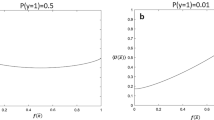Abstract
The measure of Mutual Information is used to select, out of a large number of possibly interrelated qualitative patient variables, those that are most related to the probability of occurrence of adverse incidents. The subpopulations defined by the variables selected are grouped according to risk levels while minimizing the loss of information. Results of the application of the method to predict the occurrence of three types of incidents in four hospitals are reported.
Similar content being viewed by others
References
Abramson, N. S., et al., Adverse occurrence in intensive care units,J. Am. Med. Assoc. 244(14):1582–1589, 1980.
Aronstein Safren, M., and Chapanis, A., A critical study of hospital medication errors, Part II.Hospitals 53:65–66, 1960.
Barker, K. N., Kimbrough, W. W., and Heller W. M.,A Study of Medication Errors in a Hospital, University of Mississippi, 1968.
Brown, G. C., Medication errors: A case study.Hospitals 53(20):61–62, 65, 1979.
Cooper, J. B., et al., Preventable anesthesia mishaps.Anesthesiology 49:399–406, 1978.
Fagin, I. D., and Vita, M., An analysis of 868 inpatient accidents.Hospitals 39:60–65, 1965.
Kulikowski, E. S., A study of accidents in a hospital.Supervisor Nurse 10(7):44–58, 1979.
Lee, R. G., Health and safety in hospitals.Med. Sci. Law 19(2):89–103, 1979.
Long, G., and Johnson, C., A pilot study for reducing medication errors.QRB 7(4):6–9, 1981.
Vere, D. W., Errors of complex prescribing.Lancet 1:370, 1965.
Miller, P. D.,Special Malpractice Review: 1974 Closed Claims Survey, Insurance Services Office, 1976.
Mirabella, A., Myers, T. I., and Rudov, M. H., Medical malpractice insurance claims files closed in 1970.Appendix to the Report of the Secretary's Commission of Medical Malpractice, U.S. DHEW, Washington, D.C., 1972.
Sowka, P. M., ed.,Medical Malpractice Closed Claims 1975–1978, Vol. 2, no. 2, National Association of Insurance Commissioners, 1980.
Westat, Inc.,Medical Malpractice Closed Claim Study—1976, U.S. DHEW, Washington, D.C., 1978.
Mills, D. H., ed.,Medical Insurance Feasibility Study, California Medical Association, 1977.
Pocinki, L. S., et al., The incidence of iatrogenic injuries.Appendix to the Report to the Secretary's Commission on Medical Malpractice, U.S. DHEW, Washington, D.C., 1973.
Elnicki, R. A., and Schmitt, J. P., Contribution of patient and hospital characteristics to adverse patient incidents.Health Serv. Res. (Winter): 399–414, 1980.
Andrews, F. M., Morgan, J. N., Sonquest, J. A., and Klen, L.,Multiple Classification Analysis, The University of Michigan, Ann Arbor, 1973.
Bishop, Y. M. M., Fienberg, S. E., and Hollan, P. W.,Discrete Multivariate Analysis: Theory and Practice, M.I.T. Press, Cambridge, 1975.
Goodman, L. A.,Analyzing Qualitative Categorical Data, AGT Books, Cambridge, Massachusetts, 1978.
Goodman, L. A., The analysis of cross-classified data: Independence, quasi-independence and interractions in contingency tables with or without missing entries.J. Am. Stat. Assoc. 63:1091–1131, 1968.
Shannon, C. E., A mathematical theory of communication.Bell Syst. Tech. J. 27:379, 1928.
Raz, T., and Goldman, J., A grouping algorithm for qualitative data with a dichotomous outcome variable.IIE Transactions 17(2):168–174, 1985.
Deming, W. E., and Stephan, F. F., On a least squares adjustment of a sampled frequency table when the expected marginal totals are known.Ann. Math. Stat. 11:427–444, 1940.
Guiasu, S.,Information Theory with Application, McGraw-Hill, New York, 1977.
Gokhale, D. V., and Kullback, S.,The Information in Contingency Tables, Marcel Dekker, New York, 1978.
Good, I. J., Maximum entropy for hypothesis formulation, especially for multidimensional contingency tables.Ann. Math. Stat. 34:911–930, 1963.
Ku, H. H., and Kullback, S., Interaction in multidimensional contingency tables: An information theoretic approach.J. Res. Nat. Bureau Standards (Sect B) 72:159–199, 1968.
Author information
Authors and Affiliations
Rights and permissions
About this article
Cite this article
Raz, T. An information theoretic method for classifying patients according to the risk of adverse hospital incidents. J Med Syst 10, 195–208 (1986). https://doi.org/10.1007/BF00993125
Issue Date:
DOI: https://doi.org/10.1007/BF00993125




